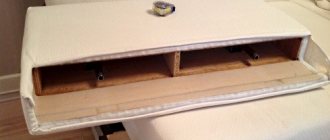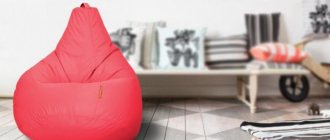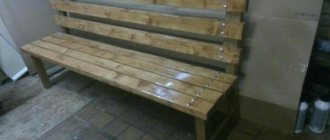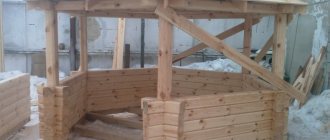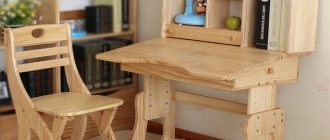If you want to freshen up the decor in your home and also dream of trying your hand at carpentry, these two desires can easily be combined. An excellent solution is to make wooden chairs with your own hands, photos of which are presented below. These pieces of furniture are always appreciated for their practicality. They will come in handy in a city apartment, in a private house, and in a country house. The usual design is simple and quite within the power of a novice carpenter. And for those who have experience, you can choose a more complex drawing of a chair with a backrest. In any case, the homemade product will certainly be in demand.
Variety of shapes and options for making wooden chairs
Wooden furniture comes in different shapes, sizes, and designs. The choice of models depends on the style of the interior and the functional purpose of the room.
DIY designer chairs are made from solid wood; options with soft inserts and upholstery are also common. Solid wood models are appropriate in many interior styles (modern, art deco, country). In rooms with high humidity conditions, models with a simple frame are optimal, because the fabric base will quickly be damaged.
Upholstered furniture is suitable for bedrooms, living rooms, and offices. Fabrics for decoration are selected taking into account the texture of the walls and textiles. Wooden chairs can be made with armrests.
Chairs in Provence style are produced with or without upholstery. Models with smooth surfaces are painted and complemented with decoupage techniques. The upholstery of products for the Provençal direction uses fabric with floral patterns.
Chair models vary in design. Products with square or trapezoidal seats look strict and elegant. The models are optimal for modern and classic styles.
Chairs with rounded seats and backs are elegant and romantic. The legs of the models are complemented by fine carvings. Options are optimal for Empire, Baroque, Vintage styles.
Models are available with the ability to transform or stationary. The choice of product type is affected by the intensity of use. Fixed chairs are selected for organizing permanent seating in living rooms and kitchens. Transformable products are ideal as additional items when holding events or receiving guests.
Whitening method for Provence style
Over time, furniture surfaces turn white. A similar result is achieved by light grinding or a special paste. When sanding, the layer of varnish and paint darkens and shines through the white coating.
The bleaching paste leaves light streaks on porous wood.
Whitening procedure:
1.Use a damp cloth to remove dust and dirt and let dry.
- Sand the varnished surface with sandpaper (grit 150-200), then with fine sandpaper.
- Apply blue or brown paint to the areas to be bleached and dry.
- Treat with wax or candle.
- Gradually, after drying, apply 3-4 layers of white paint.
- Lightly rub wax stains with a knife.
- Use soft sandpaper to smooth the surface.
Wood selection
Before you make chairs with your own hands, you need to choose high-quality material. Wood with high density is optimal (beech, elm, oak, yew). Hard rocks are difficult to process, but durable and wear-resistant. Deciduous varieties (pine, spruce) are not resistant to abrasion and chipping, therefore they are not recommended for furniture.
Chairs are made from boards or timber. You can make boards from logs yourself using a circular saw.
To create chairs with your own hands from wood, you need a material with a density of 8-12%, without cracks or fungal infections. The thickness of the boards should be no more than 100 mm. Small deviations in skew are acceptable. Treatment with antiseptic impregnation must be safe for use in the interior of the house.
There are 2 types of solid wood: solid and laminated. Whole raw materials are expensive, high quality, but difficult to process. The glued material is comfortable to finish and resistant to damage. It is possible to create budget models from pallets with your own hands.
It is recommended to purchase raw materials for furniture with a small reserve, because... When sawing, waste is generated.
Which method to choose
To transform a piece of furniture into a rare item, craftsmen use various methods, and each has its own technology and nuances. The choice of aging method is influenced by the level of wear and damage to the metal.
Painting is an affordable and uncomplicated method, provided that the furniture is strong and made of natural wood.
Abrasions are created using sanding and home patination:
- viewing the lower, contrasting layer of paint;
- using color combinations, waxing and artificial scraping.
Chemical treatment - using corrosive reagents.
When aging by fire, the surfaces are burned with a blowtorch.
Mechanical processing involves scraping with a wire brush or sand.
Bleaching and other methods.
Calculations and drawings
To create a chair with a backrest with your own hands, you need to determine the type of structure, draw a sketch, and develop a drawing. The diagram must indicate the details according to which the timber will be cut.
A homemade chair consists of a back, seat, front legs, back legs, drawers and legs. The drawing must indicate the exact dimensions of the elements. It is possible to implement an original project, but there are standard standards for the type of construction. The height of the product from the seat to the lower surface of the legs can vary from 40 to 60 cm. The distance to the armrests is also taken into account if there are elements in the product. The height from the floor to the top of the back of the chair is 80-90 cm.
How to prepare for work?
There are 3 methods of aging wood: chemical, thermal, mechanical.
There are 3 widely used methods of aging wood:
- chemical, which is only suitable for products made from deciduous trees; thermal (firing) - applicable to wood of any species; mechanical (brushing) - suitable for coniferous species and oak.
To work with wood, the following tools and materials are required:
- ax; drill or grinder with attachments; brush with metal bristles; hair brush; paint brushes; stain, acrylic paint, clear varnish, wax; sandpaper.
When purchasing boards or timber from which you plan to create an artificially aged item, you can choose specimens that have already been damaged by a bug, have chips and gouges on the surface, small cracks and knots. After processing, they will add especially charm to the “antique” item.
Wood components.
Ready-made furniture for aging is selected to be massive, a little rough or in a rustic style, similar to hand-made piece furniture of the last century. Before decorating in any way, it is best to disassemble the piece of furniture into its component parts. This will allow you to treat all surfaces without leaving untreated areas in hard-to-reach places that will catch your eye.
Before you start decorating an object for the first time, it is worth practicing and getting your hands on various discarded pieces of boards and any wood. The master will act more confidently, with knowledge of many nuances that may arise during work. Using these same tutorials, it is convenient to select the tone of paints or stains, and evaluate in advance what the result will be.
Many operations (brushing, painting and drying after it, firing) should be performed outdoors.
The process of making a chair with a backrest
After sawing the elements, sequential assembly of the chair parts is carried out. First, the front part of the furniture is assembled from the transverse drawer, legs, and lower lintel. It is important to maintain the right angle of the structure; measuring instruments are used for this. It is better to fasten the product with screws.
Then the back is created. It is necessary to insert longitudinal jumpers and drawers into the grooves on the front surface of the backrest. The chair apron is assembled and connected to the front part. A seat is mounted to the finished frame.
To ensure high-quality assembly of wooden chairs with your own hands, it is recommended to make preliminary fastenings to the model in order to determine the joining distances of the elements and check that there are no distortions. If necessary, the parts are adjusted, then sequentially assembled, glued and connected. The frame parts are connected without metal fasteners, only the seat is fastened with self-tapping screws, which are screwed in from the drawer side.
It is possible to make a chair from wood without preliminary assembly if you use a filler router, which ensures precision in fitting the elements.
Seat
The seat is made of plywood panel or board 15-20 mm thick. The standard dimensions of the element are 430*440 mm, but it is possible to manufacture the part according to the author's design. On the short side, you need to mark the places for the openings and use a cutter to make recesses for further fastening the backrest. The right corners of the seat and the edges of the panel must be processed with a router for comfortable operation of the product.
Legs
Chair legs can be straight or curved, connected in the shape of a rectangle or square.
To make the rear legs, boards 25 mm thick are required. Markings are applied to the slabs according to the diagram, measured using a ruler, and grooves are marked for installing the crossbars of the rear drawer and backrest. Before cutting, it is necessary to drill out the grooves with a router or drill. The hole dimensions should reach a diameter of about 9 mm.
Then the legs are cut out and the surfaces are processed. On the finished legs, additional grooves are marked and drilled for installing side drawers. The elements are connected, during the process it is necessary to pay attention to the difference in the length of the elements.
Back
The back of the chair can be solid, hard, prefabricated, or soft. In the classic model, the back includes a wide horizontal strip, narrow jumpers (upper and lower) and vertical strips. The height of the backrest is calculated from the seat, not from the armrests. The first overlap on the back for support is placed 15 cm from the seat. The parts are assembled using fasteners (screws, dowels) and completed with the adhesive method.
Additional Tips
If you make furniture from solid wood, it is important to ensure that it is not only beautiful, but also safe. This is especially necessary if there are small children in the house. So, all surfaces and corners of boards and bars must be sanded. Then they should be painted or treated with stain and varnish. As for the latter, it is better to use one that is odorless - water-based. This way you can be sure that the coating is harmless.
It has already been said above what kind of wood chairs are usually made from. But there are some nuances here too. Red rocks, for example, look simply gorgeous and have a beautiful structure. Linden is lighter than oak, but with the help of stain it can be tinted to match it. Carved chairs look beautiful in elegant interiors. So if you have carving skills, do not miss the opportunity to practice on the back and even the legs of the product.
If you are making furniture for a baby, do not use metal corners, because he can get hurt on them. The parts can be connected with screws or dowels. To make the structure more stable, simply choose thicker parts.
Decoration
Furniture assembly work ends with decoration. Before decoration, the surfaces are treated with sheets of sandpaper and coated with clear varnish. Decoration is carried out using the techniques of decoupage, patination, engraving, simple or artistic coloring, etc.
Wood carving allows you to create original patterns and engravings. The design can be contour, geometric, relief, etc. Fine carving will give the room lightness and airiness. After engraving, the product is coated with transparent varnish or thick paint. The design method is suitable for rooms in the Art Nouveau, Baroque, and Shabby Chic styles.
Antique chairs are decorated with your own hands using decoupage techniques. Furniture is complemented with floral prints or reproductions of art paintings, artificially aging the surface. The work is completed by varnishing the surfaces. The decor will suit rooms in retro, vintage, Provencal styles.
Coloring allows you to harmoniously fit furniture into the interior, making models contrasting or neutral. When applying enamel, it is possible to use patination techniques, stylization like marble and glass. Paints can be translucent or dense depending on the interior design.
Features of coloring techniques
Many people are interested in the question of where to buy antique furniture. This can be done in a furniture showroom or ordered from a workshop.
If you know how to use a tool, then the problem can be solved at home, using, for example, the painting method. There are several technologies for carrying out such work.
Crackle
After its application, microcracks appear on the surface. The work algorithm is as follows:
- prepare the surface;
- apply the first layer of paint to form the base;
- allow to dry, and then cover with craquelure composition, making unidirectional strokes;
- For the final coating we perform tinting;
- any cracks that appear are fixed with furniture varnish
Patina
This effect is manifested in greenish-bronze veining. To get them you need:
- coat the furniture with protective varnish;
- allow the mixture to dry and apply a patina;
- in 30-40 minutes. the surface is treated with a brush - greater effort leads to a brighter effect;
- remove dust with a rag;
- The last layer of furniture varnish is applied - in the photo of antique furniture you can see the result of the work.
Coloring
Work is carried out using several paints:
- First, the surface is processed to create the effect of unevenness.
- To preserve the texture, a layer of paint is applied.
- Sandpaper creates abrasions.
- Cover the plane with a different color and shade it.
Artificial pollution
To create this effect, you need to cover individual areas with wax in one direction with gaps, and then apply varnish. If there are recesses, they become darker due to paintwork materials, which emphasizes the antiquity.
Therapeutic effect
The knee orthopedic chair model allows you to adjust the seat height, adapting to everyone. With a correctly adjusted chair, the load is distributed approximately 60 to 40. Of this, 40 percent of the load goes to the knees and only 60 to the pelvis. This allows you to significantly relax your back muscles and take a comfortable position without tilting your body forward. Those. You will feel comfortable sitting on such a chair with a straight back.
A feature of the kneeling chair is the redirection of the load from the lower part of the spine to the muscles of the legs, while maintaining a vertical position of the back, the shoulders remain straightened.
Doctors and orthopedists advise purchasing such a chair for schoolchildren and students who have to spend a lot of time sitting in class.
Since its inception, when the chair had only a seat and a knee rest, its design has acquired many innovations.
Joiner's tenon joints
To make a chair with our own hands, we will have to thoroughly master furniture (carpentry) tongue-and-groove joints. Basic information about them is given in the article about a do-it-yourself stool; Here we will mention something in relation to the chair.
Open connections and with through tenons in chairs for the sake of aesthetics are rarely used, as are connections reinforced with hardware: bolts, confirmations, self-tapping screws. A nail in a chair is basically the same as a car hood tied with rope.
The chairs are assembled using blind tongue-and-groove joints that are invisible from the outside; they are sometimes called miter joints. Assembly is done with gluing; wedging of tenons is often used, because They don't make regular chairs with removable legs. A chair with wedged tenons is more labor-intensive, but very strong and durable, because all parts of the connection dry out together.
How to make a blind groove (hole) for a tenon is shown in Fig. If you have a hand-held wood router, then you don’t need to pick out the excess with a chisel, but you do need to drill the edges of the hole: it’s easy to just “go away” with an end mill. In this case, the edges of the tenon are also rounded, but it will only be neater and stronger.
How to make a groove for a furniture tenon by hand
It seems strange, but it is with tenons that amateurs most often have problems: it is difficult to saw a workpiece for it with a hacksaw without “scratching” the base of the tenon, and a tenon sawed at the base is an unacceptable defect, because the strength of the connection drops sharply. Deliberately under-saw and remove the fold (extra wood around the tenon) with your hands - the tenon may come out “plump” or oblique, which is no more acceptable. Therefore, it is best to make furniture tenons using a router with some simple devices, see video:
Video: how to make a furniture tenon with your own hands
Operating rules
The main goal of orthopedic developments is the prevention and treatment of diseases of the musculoskeletal system. This chair was no exception.
The positive result after its use gives grounds for orthopedic doctors to recommend the knee chair to their patients.
An orthopedic knee chair is recommended both for healthy people who want to maintain their supporting apparatus into old age, and for patients with medical prescriptions.
Of course, it will not solve your problems, but if used correctly, it will greatly alleviate your posture problems.
In order for you to sit comfortably on such a chair, it is important to correctly adjust its height, namely the distance between the knee support and the seat itself.
Correct posture helps restore the natural curves of the spinal column in mild to moderate scoliosis, completely preventing its development in the future.
Also, do not forget to periodically get up from it and do a short walk, warm-up or physical exercise to improve blood flow in the lower extremities.
Kneeling chairs often take some getting used to. Start with 10-15 minutes a day, gradually increasing the time you sit on it. If you feel discomfort when sitting on this chair, and you can’t get used to it, give up this idea. Listen to your body.
Many owners of this wonderful invention recommend alternating its use with conventional orthopedic chairs so that the frequency of loads in the sitting position changes.
Paint bleed effect
After two coats of paint have been applied, lightly apply paint of a different color. This should be done using a dry brush, touching it only in certain places. For a greater contrast effect, it is recommended to use colors that differ in shades. For example, if the main color of the chairs is blue, then olive-colored paint may also show through on the surface. This technique is called “dry brush”, and such work can be done as follows. A dry brush should be dipped a little into the paint, and then wiped with a dry rag. The tool is now ready to apply an almost transparent layer of paint to the pre-painted base. This technique can also be used in cases where it is necessary to obtain the effect of old paint that has become ingrained into the wood.
Tools
Tools you will need:
electric jigsaw or wood saw;- sanding machine or sandpaper of varying degrees of grain;
- drill with a set of drills;
- self-tapping screws;
- screwdrivers or screwdriver;
- furniture stapler;
- hammer.
Prepare from materials:
- lumber (in our case, boards and plywood for seating);
- stain;
- paints and varnishes;
- brush;
- upholstery fabric;
- wood glue;
- foam rubber
Color spectrum
The palette of colors for kitchen sideboards made of antique wood is created by staining.
The color scheme can be:
- neutral (all shades of white, black, gray);
- natural (natural shades of wood);
- exotic (atypical shades of purple and blue).
Water stain has a wide variety of shades, but
- they are all natural;
- during processing, wood fibers rise;
- resistance to moisture decreases.
The most extensive palette of stains on acrylic. This allows you to create atypical shades. The fibers do not rise, the structure of the material is completely preserved. Wax-based compositions have similar properties.
The most modern stains are produced in the form of gels. They are thick, so they are applied with a swab. Because of their pungent odor, they are used reluctantly, replacing them with formulations based on oils and water. Interesting effects are obtained by combining colors. This is clearly visible in the antique wood kitchen from the manufacturer.
History of appearance
In 1970, the Danish scientist Mendel observed and studied the postures of people leading a sedentary lifestyle, office workers, and schoolchildren. Considering the way they sit, he came to the conclusion that the most comfortable position for sitting on a regular chair is to tilt the body forward relative to the pelvis. It is this constantly repeated body position that leads to curvature of the spine and other back diseases.
For many decades, scientists have been trying to find a design that would fully meet all the requirements.
From this, he designed a chair whose seat was tilted downward by 15 degrees. This structure helped maintain correct posture, but had its drawbacks. A person sitting on such a chair constantly rolled off it.
The most useful chair is one whose seat is located at an angle of 15° relative to the horizontal.
A number of researchers from Norway became interested in Mendel's work and in the course of development, they improved the kneeling chair by inventing a knee rest. Thus, they were able to evenly distribute the load on the buttocks and knees, and the spine began to serve as the center of gravity. The body of the person sitting reflexively straightened at the slightest tilt forward.
The result was a chair with a footrest in a half-bent position, on which one stood with one's knees.
One of the developers of such a chair was the owner of the furniture factory, Peter Opsvik. It was thanks to him that such a chair hit the store shelves.
Drawing
The dimensions of the bars that will be needed when making a kneeling chair are indicated in the drawing (click on the picture to enlarge).
3D model of the future kneeling chair looks like this
Creative, original ideas
There are a huge number of options for creating original, one-of-a-kind chairs, for example:
- old chairs, from which only the frames remain intact, can be reupholstered with different fabrics, their seats can be woven from ropes, belts, narrow strips of leather, rubber;
- from an ordinary wide stump, in which a semicircular recess is cut, the strongest chair for the garden will come out;
- if you attach legs and soft seats to iron buckets, they can also be placed around a garden table;
- Pieces of old skis and skateboards, if you fasten them together correctly, will also make comfortable furniture for sitting;
- the back and seat of a homemade wooden chair are made in the shape of a funny or scary face;
- a product made from carefully fitted, sanded, varnished driftwood will decorate an ecological style room;
- The coloring of furniture in the form of a two- or three-color gradient tint looks interesting;
- You can also build an armchair from several pallets and old hardcover books;
- a kind of soft swing-hammock is fixed to the ceiling beam, woven from strong, thick twine;
- comfortable stools will be made from car tires, ropes and pieces of wood.
